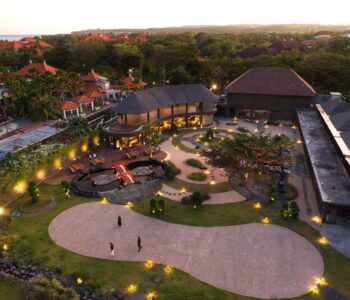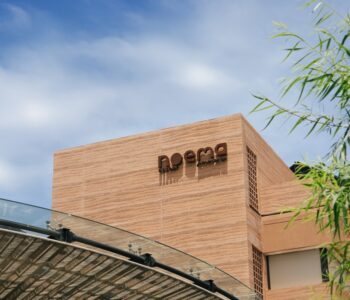
To fully understand the life cycle rites in Bali, one must first recognise the unique character of Balinese religion–a local system rooted in ancestor worship and the veneration of natural forces, onto which a Hindu belief structure has, since independence, been layered in a largely syncretic manner. While formal Hinduism is increasingly visible in ritual and institutional practice, it is still the ancestral cult that governs, through numerous local variations and shifting references to the Hindu pantheon, the core rites of the Balinese life cycle.
A key divergence from orthodox Hinduism lies in the Balinese belief that individuals are typically reincarnated within their own kin group and within the island itself. Ancestral souls are said to dwell above the island’s mountains in a spiritual realm often referred to as “the old country” (tanah ane wayah). Notably, considering the importance of water in Balinese agricultural life, these purified ancestors—having undergone post-mortem cleansing in the underworld—are believed to dwell in the “old country” as yeh or toya, meaning pure water. In this cosmology, reincarnation is natural and desirable, unlike the Indian Hindu view, where reincarnation is a karmic burden.
Life begins in the womb, marked by the first ceremony. From birth through adolescence, adulthood, and ultimately death, the individual—seen as a new being or a returned ancestor—passes through a series of life cycle rituals. Throughout life, they are protected by ancestral spirits, honored during temple festivals, while also guarded against buta kala and other harmful forces through a sequence of exorcisms and apotropaic rites. The overarching purpose of these rituals is to guide the individual toward death and their eventual return to the ancestral “old country.”
The Life Cycle Rites
Conception

The first step of incarnation is, under the umbrella of the god and goddess of love, the meeting of the “white desire” of the man (kama petak) and the “red desire” of the woman (kama bang). The merging of their material components (pancamahabhuta) as an embryo enables one or several waiting souls to come down as ancestral warih (descendants), or people. Yet, attracting the right ancestor(s) is no simple matter—magic and mystical nakti wakes in ancestral shrines, especially among aristocratic families, are part of the process to receive the visit of a long-dead powerful parent.
Megedong-Gedongan

The megedong-gedongan ceremony is highly important because it affirms the presence of the foetus (jabang bayi) as a complete being in the mother’s womb. Megedong-gedongan means “to be housed” (gedong). It normally takes place in the seventh month of pregnancy. By then, according to Balinese syncretic beliefs, the gods from the Hindu pantheon inhabit the various physical parts of the body, affirming the future individual as a microcosm (Bhwana Alit) that mirrors the structure of the Universe (Bhwana Agung). Shiva occupies the head—hence it is forbidden to touch it. Brahma occupies the stomach, Vishnu the liver, etc. The whole pantheon is present. The foetus is also accompanied by its four “little brothers”—the future afterbirths—that will protect it after birth.
Birth and Mapag Rare (Welcome Ceremony)

Birth is a dangerous moment, as it implies transformation and the involvement of forces from beyond the world: an ancestor is coming down. Leyaks and other evil forces are on the lookout. After the baby enters the human world, the afterbirths—the residence of the four kanda mpat brothers—are collected and wrapped in a coconut shell; a sacred letter is written on it and the small container is buried in front of the entrance of the north pavilion of the family compound—on the left for a girl, and on the right for a boy. The baby has no name yet. It is referred to as dewa, or god, because it is the incarnation of one or possibly several deified ancestors.
On the occasion of birth, a Kumara shrine—a temporary shrine—is built in the family compound to house the baby-god Kumara, so that he may honor and protect the newborn child.
All the following ceremonies, up to the first otonan, aim at anchoring the incarnating soul’s presence on earth until it eventually touches the ground (napak siti) for good during the third-month ceremony.
Kepus Pungsed (Severing the Cord) and Post-Birth Ceremonies
Held soon after birth, the ritual cutting of the umbilical cord marks the physical and spiritual separation from the womb. Offerings are made to the kanda mpat—the four invisible siblings who accompany the child through life.
When a child is still a newborn, its fontanelle, called Shiva’s door, is not fully closed. The head, especially the fontanelle, retains a special role. It is protected by a special loloh herbal concoction accompanied by prayers; otherwise, it may not be touched.
Ngrorasin (Twelve-Day Ceremony)
This is probably, along with the mapag rare ceremony, the most important introduction of the incarnating ancestor into human life. Two short ceremonies are held: one for the kitchen and its fire god Brahma, and another for the well and its water god Vishnu. This is when the parents go to the balian tetakson (inspired shaman) to seek insight into who is incarnating. The balian provides information through trance or pewisik revelation that helps visitors guess which grandparent, aunt, or other ancestor is coming down. The incarnating soul may also make specific requests—such as a dance or puppet show—to ward the child from illness. Based on these revelations, the child is given a name, often reflecting the ancestor, including auspicious elements, or referring to birth order, caste, or calendar timing. However, this name is not used until the first anniversary in the 210-day Pawukon calendar. By the twelfth day, the child is considered fully anchored to life on earth and much less threatened by diarrhea and other illnesses that, until fifty years ago, killed one-third of infants before their second week—kaambil, taken by unknown forces, as people said.
From the twelfth day onward, the child is regarded as a full human being. However, their future welfare will depend on the fulfillment—by both child and parents—of ritual duties to gods and demonic forces alike.
Tutug Kambuhan (Forty-Second Day Ceremony)
The Tutug Kambuhan ceremony in Balinese culture is an important postnatal ritual held on the 42nd day after birth, based on the 210-day Pawukon calendar (which counts in 7-week, 6-day cycles). It is a ceremony for both the mother, whose postnatal impurities are cleansed, and for the newborn, whose four kanda mpat “little brothers” are ritually sent to their proper domains—lest they threaten, rather than protect, the child.
Telubulanin (Three-Month Ceremony)

At three months, the telubulanin rite marks the first time the child’s feet touch the ground (napak siti). Until then, the infant is carried and not allowed to make contact with the earth. This ceremony affirms the child’s full integration into the world and the community. It acknowledges the child’s physical and spiritual readiness to live on earth.
Before the baby is formally allowed to touch the earth in telubulanin, a symbolic visit is often made to a balian (traditional healer or spiritual guide). The baby is placed on the ground to spiritually “introduce” them to the earth and to consult the balian for signs, omens, or ancestral identity. This may occur around or before tutug kambuhan, depending on family tradition.
Otonan (Balinese Birthday Ritual)

The otonan—from wetu, meaning “to come out”—is held on the child’s wuku anniversary, corresponding to their birth date, repeated every 210 days according to the Balinese calendar. From that time onward, the child is considered part of the local community. The event is communal, with the participation of all members of the banjar (neighborhood). Hair is ceremonially cut for the occasion. The Kumara shrine of the baby-god is dismantled, as the child no longer needs divine protection.
The otonan anniversaries, observed every 210 days, continue to be celebrated at the family shrine throughout all phases of life.
Menek Kelih (Introduction to the Senses and Social Awareness)
Menek kelih marks the beginning of the child’s perceptual and social development. The child is introduced to language, basic religious knowledge, and community norms. This rite acknowledges that the child is no longer a passive recipient of care but is beginning to interact consciously with their surroundings. It serves as a transitional ceremony into early childhood and educational preparation.
Mepandes: The Tooth-Filing Ceremony


One of the most well-known ceremonies of Balinese ritual, undertaken under the guardianship of a twice-born priest (sulinggih), it consists of the filing of six upper teeth, known as mepandes or metatah. It symbolizes, upon reaching adulthood, the control one must have over the six inner enemies (sadripu): desire, greed, anger, intoxication, confusion, and jealousy.
Other Life Cycle Rites
The childhood rites cover only part of the life cycle. Marriage rites follow, with the hope of producing a sentana (heir) who will maintain the ancestral shrines and rituals. These are followed by post-death, cremation, and post-cremation ceremonies, through which the individual reenters the pool of “water” ancestors above the mountains, awaiting their return to the island of Bali.









